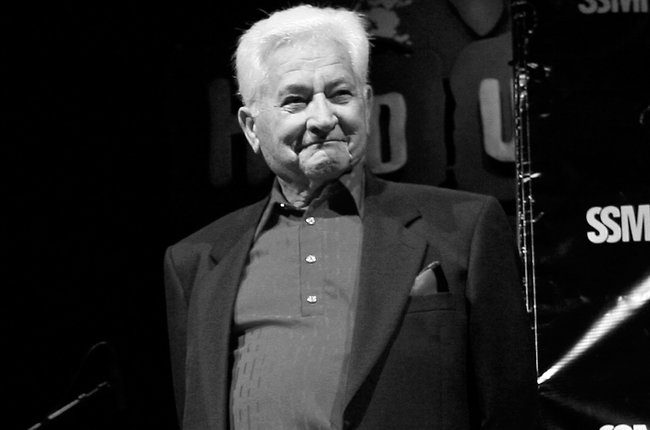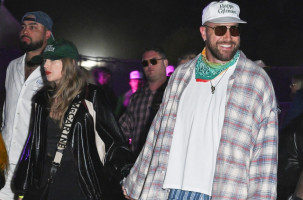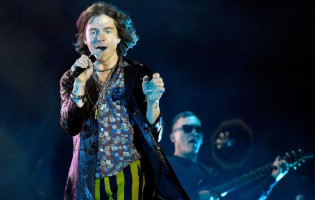The Rock and Roll Hall of Fame inductee first met Maglieri in 1964 when the Whisky opened its doors.
When Mario Maglieri, the co-owner of two of L.A.'s most iconic Sunset Strip venues in The Whisky A Go Go and The Rainbow Bar and Grill passed away earlier this month at the age of 93, the city lost an integral part of its rich music history. For more than a half century, Maglieri, a.k.a. "The King of the Sunset Strip," helped foster an unrivaled rock and roll scene and lore that traveled far beyond the Strip's confines.
The Whisky's illuminated marquee at the corner of Sunset and San Vicente when put together reads like a who's who of the rock canon: from OG rock and rollers The Doors, Janis Joplin, The Byrds, Led Zeppelin and Jimi Hendrix; to next gen punkers Iggy and the Stooges, The New York Dolls, The Ramones, The Germs, The Cramps, Blondie and X; to devil-horning head-bangers like Motorhead, Van Halen, AC/DC, Metallica, Guns N' Roses, Motley Crue and too many hair metal bands to count all graced the Whisky's corner stage. This while legends like John Lennon, David Bowie, Lemmy (of course), Keith Moon, Neil Diamond and Harry Nilsson got their drink on at the Rainbow -- all of whom would help burnish the Strip's reputation as a Mecca of rock and roll vice, virtue and otherwise.
"He had a great passion for the performers and their music," says Lou Adler, Maglieri's longtime friend and business partner. The songwriter, producer, label owner, manager and Rock and Roll Hall of Fame inductee first met Maglieri in 1964 when the Whisky opened its doors with his act Johnny Rivers. He later partnered with him on the Rainbow, where Maglieri would spend many nights until 2 a.m. and where the duo had just met up only a few months back. Following Maglieri's passing, Billboard reached out to Adler to get his take on the "King of the Sunset Strip" and his lasting legacy.
Where do you think Martin Maglieri fits in to the pantheon of the Sunset Strip?
As far as Sunset Boulevard there were two people responsible for turning the lights on so to speak: That would be Elmer Valentine and Mario Maglieri. Mario's passion for the artist took him to the music. He wasn't a big rock and roll music fan at first, that wasn't his genre of music that he loved, but he became a lover of rock and roll mostly because of his personal relationships with people who performed there.
What do you mean "Turned the lights on?"
He helped turn the lights on the Strip after those Ciro's days of the 1940s. In the 1950s it sort of moved around to The Cloister and the Interlude, where they had comedy like Lenny Bruce and Bobby Darin who played his big band stuff there in 1963. There were some attempts to bring rock and roll to Ciro's I think in '63, but mostly it had moved down around the Interlude, But rock and roll came back strong in 1964 with the opening of the Whisky

John Densmore of the Doors said Mario was working the door at the Whisky when he met him.
He started out as a manager of the Whisky. Elmer opened the Whisky and Mario was the manager. He had a couple of clubs of his own I believe before that. He had a real toughness about him, he was one of the toughest guys I've ever known in my life. You were either someone he liked or someone he didn't like. He was my partner for over 40 years and I think he started to like me in about the 38th year [laughs].
Do you remember first meeting him?
Well I met him at the Whisky, Johnny Rivers who I was producing and managing, opened the Whisky as the house performer. Mario was the manager at that time so I met him during that period. That would have been 1964. I was a partner in the Whisky for a while; I am now in the Rainbow and Elmer and I opened the Roxy. I still own the Roxy with my sons, the most prominent of whom is Nikolaj (a.k.a. Nic).
Was your relationship with Mario business or social?
Most of Mario's social life took place at the Rainbow and he spent every night there until 2:00 a.m. in the morning or later. On certain nights in the early days, after 2 o'clock in the morning, he'd go downtown to the markets and buy vegetables and fruits. He was consumed with the business and that was his social life. In the later years it tuned into lunches instead of dinners and he would come have lunch there every day.
What were some of your most memorable experiences with Mario?
Every night was an experience with Mario in one way or another. Everything was tied to how he ran that club. He will always be the face of the Rainbow, the heart and soul of it. And he was concerned with every aspect of it until the end. He would stand by the kitchen as the bus boys came through and if there was food left on one of the plates he would go right to that table and find out what was wrong with it. That's the way he was. If he had a passion for something it consumed him, that's what he did.
So it wasn't just about the music.
No, I think it was the people more than the music. Most of the metal groups, Motley Crue, Guns N' Roses, those groups he was very close with. And when he was at the Whisky it was the Doors. He had this sort of godfather/father thing with Morrison. As much as he was tough on Morrison, if he did something on stage he was always concerned with Morrison's health. It was definitely a father-godfather thing.

Densmore mentioned he had punched out some people.
He was tough, one of the toughest guys I ever met but he also had a big heart, which balanced it all out. He would do anything to help you, but if you crossed him you were out. And it was an easy sort of cross. He was very sensitive. If you did something that just wasn't right towards him or his family or the club, he was quick to pull that trigger.
As a producer and label owner, would you go down to the Strip to see bands you'd never seen or meet colleagues? Was it like instead of picking up the phone, you could have a dozen real-time experiences?
I didn't work on a day-to-day basis at any of the clubs or the restaurant, Elmer pretty much did the booking at the Whisky in the early days and he did the booking at the Roxy. Mario ran the Rainbow. I was there all the time because it was my lifestyle at that time to be on the Strip in the 60s but I didn't do the day to day business with any of those clubs.
You recorded Johnny Rivers at Live at the Whisky, right?
Yes I did three albums there. Johnny Rivers Live at the Whisky a Go Go, and there were two other Live at the Whiskys.
Did Mario have a hand in any of those albums.
No, he ran the club and I ran the music. I had a label and I had people producing although some of the bands might be playing the club, mostly Johnny Rivers, but I had a separate career going at that time.
Was that Dunhill Records?
It started in 1964, Johnny Rivers, so yes Dunhill.
Later when you were at Ode Records were you signing artists off The Strip?
As I look back at it, no not at all. During that period in the 60s, most of the groups that I produced— well Spirit played those clubs—but the Mamas & Papas didn't play those clubs.
What are you working on these days?
Right now I'm immersed in Monterey Pop 50. You have to read the article in Billboard that's about to come out. There's an exhibit at the Grammy Museum and there's a celebration of Monterrey International Pop Festival 50 in Monterrey on the same days and dates that it took place in 1967.
The Strip is associated with all these rock and roll legends and classic music as well as all kinds of decadence and debauchery, do you have any anecdotes from then?
Well, everything you just mentioned [laughs] but nothing that I would point out in particular. It was such a great lifestyle in the 60s. All the performers--everyone who was happening in pop music and certainly from the West Coast—congregated at the Whisky and later at the Rainbow and then later at the Roxy. It was just a tremendous lifestyle.
Did you meet John Lennon there?
Well Lennon and I came into contact not because of there but before then actually, he stayed at one of my houses. The Beatles in '65 or '66 came to the Whisky. Lennon and Ringo, who stayed around LA during the 1970s would be around On The Roxy, which is above the Roxy and Over The Rainbow, which was above the Rainbow. You didn't' see McCartney or George Harrison around L.A. that much.
Do you get to the Strip much these days?
No, not a lot. I will go by the Roxy to meet somebody sometimes. There were times over the last year or so when I would go by to see Mario and have lunch at the Rainbow, but I don't get down there much.

When was the last time you had lunch with Mario?
It wasn't lunch with Mario, he'd be having lunch and I'd sit there. That was probably within the last 4-5 months. He was having some health issues, but he never did really fizzle out, he sort of went before that happened.
How do you think Mario should be remembered
He would want to be remembered as the King of the Sunset Strip. And that the Strip never died, although it was referred to from time to time, he did whatever he could to keep it alive both in image and the way he treated people and took care of everything, especially the performers. He had a great passion for the performers and their music.








